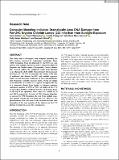Files in this item
Computer modeling indicates dramatically less DNA damage from far-UVC krypton chloride lamps (222 nm) than from sunlight exposure
Item metadata
| dc.contributor.author | Eadie, Ewan | |
| dc.contributor.author | O’Mahoney, Paul | |
| dc.contributor.author | Finlayson, Louise | |
| dc.contributor.author | Barnard, Isla Rose Mary | |
| dc.contributor.author | Ibbotson, Sally Helen | |
| dc.contributor.author | Wood, Kenneth | |
| dc.date.accessioned | 2021-07-14T15:30:11Z | |
| dc.date.available | 2021-07-14T15:30:11Z | |
| dc.date.issued | 2021-07-05 | |
| dc.identifier | 274800173 | |
| dc.identifier | 1392c699-8957-4cd6-9de4-cf40e9b1a4b6 | |
| dc.identifier | 000669629500001 | |
| dc.identifier | 85117166164 | |
| dc.identifier.citation | Eadie , E , O’Mahoney , P , Finlayson , L , Barnard , I R M , Ibbotson , S H & Wood , K 2021 , ' Computer modeling indicates dramatically less DNA damage from far-UVC krypton chloride lamps (222 nm) than from sunlight exposure ' , Photochemistry and Photobiology , vol. Early View . https://doi.org/10.1111/php.13477 | en |
| dc.identifier.issn | 0031-8655 | |
| dc.identifier.other | RIS: urn:2AC6B4A62F646A7596361FA53B0E2E19 | |
| dc.identifier.uri | https://hdl.handle.net/10023/23567 | |
| dc.description | Funding: Dr Paul O’Mahoney is funded by Medi-lase (registered charity SC037390) and the Alfred Stewart Trust. Dr Isla Barnard acknowledges financial support from an UK EPRSC PhD studentship (EP/N509759/1) and Louise Finlayson acknowledges financial support from EPSRC Industrial Doctorate Centre Scheme (2262922) and the Laser Research and Therapy Fund (registered charity SC030850). | en |
| dc.description.abstract | This study aims to investigate, with computer modeling, the DNA damage (assessed by cyclobutane pyrimidine dimer (CPD) formation) from far-ultraviolet C (far-UVC) in comparison with sunlight exposure in both a temperate (Harwell, England) and Mediterranean (Thessaloniki, Greece) climate. The research utilizes the published results from Barnard et al. [Barnard, I.R.M (2020) Photodermatol. Photoimmunol. Photomed. 36, 476?477] to determine the relative CPD yield of unfiltered and filtered far-UVC and sunlight exposure. Under current American Conference of Governmental Industrial Hygienists (ACGIH) exposure limits, 10 minutes of sunlight at an ultraviolet (UV) Index of 4 ? typical throughout the day in a temperate climate from Spring to Autumn - produces equivalent numbers of CPD as 700 hours of unfiltered far-UVC or more than 30,000 hours of filtered far-UVC at the basal layer. At the top of the epidermis these values are reduced to 30 and 300 hours respectively. In terms of DNA damage induction, as assessed by CPD formation, the risk from sunlight exposure greatly exceeds the risk from far-UVC. However the photochemistry that will occur in the stratum corneum from absorption of the vast majority of the high energy far-UVC photons is unknown, as are the consequences. | |
| dc.format.extent | 5 | |
| dc.format.extent | 406418 | |
| dc.language.iso | eng | |
| dc.relation.ispartof | Photochemistry and Photobiology | en |
| dc.subject | QA Mathematics | en |
| dc.subject | QH426 Genetics | en |
| dc.subject | NDAS | en |
| dc.subject.lcc | QA | en |
| dc.subject.lcc | QH426 | en |
| dc.title | Computer modeling indicates dramatically less DNA damage from far-UVC krypton chloride lamps (222 nm) than from sunlight exposure | en |
| dc.type | Journal item | en |
| dc.contributor.institution | University of St Andrews. School of Physics and Astronomy | en |
| dc.contributor.institution | University of St Andrews. Centre for Biophotonics | en |
| dc.identifier.doi | 10.1111/php.13477 | |
| dc.description.status | Peer reviewed | en |
This item appears in the following Collection(s)
Items in the St Andrews Research Repository are protected by copyright, with all rights reserved, unless otherwise indicated.

